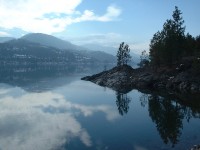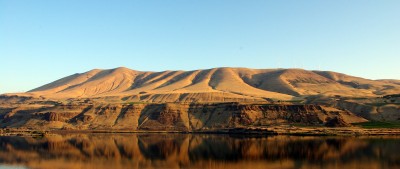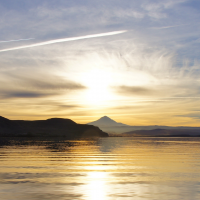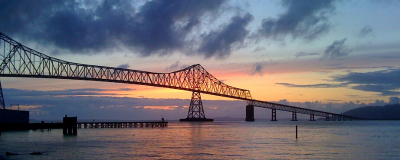In a powerful essay, Columbia Riverkeeper’s staff attorney, Simone Anter, Jicarilla Apache and Yaqui, explores and articulates how Black Lives Matter is inextricably tied to environmentalism and Columbia Riverkeeper’s work.
Environmentalists for Black Lives Matter Because, Yes, Police Brutality is Tied to the Environment
Simone graduated from UCLA School of Law in 2017 with a specialization in Critical Race Studies and a focus on Indigenous human rights. She obtained her bachelor’s degree from the University of Oregon where she majored in Philosophy and Sociology, focusing on social inequality and the environment.
As I write this, people march across the world demanding an end to police brutality, structural racism, and echo the call that Black Lives Matter. As companies and nonprofits, including Columbia Riverkeeper, issue generic statements about listening, learning, and supporting these demands, I see few actually taking the time to turn inward and explicitly connect how systemic racism and police brutality DIRECTLY impact that work, whatever that work may be. However, numerous Black authors in every field have done just that over the years. It is in their words, and by providing a platform to elevate these voices, that I seek, through heavy quotation, to explore and articulate how Black Lives Matter is inextricably tied to environmentalism and Columbia Riverkeeper’s work.1 If people cannot articulate the ways in which police brutality and systemic racism impact their work, dismantling these systems of oppression is near impossible. The hope is that through this essay people can more fully see the connection.
This writing focuses solely on Black experiences with the environment and environmentalism. As an Indigenous person, I do not purport to know that experience. For this reason, I use quotes from Black authors who have written on the topic. Focusing on the Black experience at this time in no way diminishes how other People of Color or Indigenous people have also suffered similar experiences but one must realize that when Black lives matter, all lives matter.
Opal Tometi, one of the founders of Black Lives Matters, pointedly explained in 2016 that “what we need now more than ever is a human rights movement that challenges systemic racism in every single context.”2 For us at Columbia Riverkeeper, that context includes our environmental work along the Columbia River. Militarized police brutality is both a product and the enforcer of systemic racism every day. Structural racism impacts every aspect of the environmental movement, from who is allowed to access outdoor spaces, who is hardest hit by climate change, and who is allowed to be an environmentalist and make a living in that field. Ibram Kendi breaks down the following definitions to emphasize how all policy is inherently about race, “Racist Policy: says exactly what the problem is and where the problem is. ‘Institutional racism’ and ‘structural racism’ and ‘systemic racism’ are redundant. Racism itself is institutional, structural, and systemic.”3
Kendi continues,
"A racist policy is any measure that produces or sustains racial inequity between racial groups. . . . By policy, I mean written and unwritten laws, rules, procedures, processes, regulations, and guidelines that govern people. There is no such thing as a nonracist or race-neutral policy. Every policy in every institution in every community in every nation is producing or sustaining either racial inequity or equity between racial groups."
Given that no policy is race neutral as a starting place, one can turn inward and more fully grasp how the environmental movement is far from race neutral. Of course, environmental justice is a strong buzzword right now, typically defined as fighting for the involvement of all people with respect to development, implementing, and enforcing environmental laws and policy.”4 It also acknowledges that people of color and their neighborhoods are the first and hardest impacted by climate change and are the most likely impacted by industrialization and/or extractive industry that poisons the air and water. The systemic causes of these disparities are race based. Environmental justice and how it is colloquially discussed—especially in this moment—fails to fully account for how police brutality as a product and enforcer of systemic racism has also directly shaped the environmental movement.
Structural racism impacts every aspect of the environmental movement, from who is allowed to access outdoor spaces, who is hardest hit by climate change, and who is allowed to be an environmentalist and make a living in that field.
The Environment as a White-Only Space
When you ask a person working in the environmental field why they fight for the environment, the answer usually includes some childhood memories of camping trips, fondness for outdoor activities, a breathtaking visit to a National Park, or some other life-changing experience rooted in the beauty of the natural world. However, what is often overlooked is the profound way in which the natural world has been claimed as a white-only space, where people of color, and specifically Black people, have been systematically excluded and policed from accessing. Joshua Walker, a travel blogger and outdoor enthusiast writes:
"Growing up, because I was young and impressionable, I also aligned myself to the belief that there were things in life that were inherently just for white people. That long list included camping, hiking, skiing, most water sports, skydiving, etc. And while I personally always wanted to try some of the outdoor activities I considered off-limits, I did not feel like I would fit in for two reasons: I was black and most of the kids that did those things also didn't make it a habit of hanging out with black kids."5
Walker goes on, “While I understand the phrase ‘different strokes for different folks,’ this issue, in my opinion, is much more deeply rooted than a mere matter of taste. I believe it to be the byproduct of systemic racism.” 6
The Atlantic, in its collaborative Action Plan for Change, further emphasizes the outdoors as a white-only space. “[A]according to the most recent National Parks Service survey, about 78 percent of those who visit federal parks are white. Meanwhile, African Americans, Latinos, women, and members of the LGBTQ community often report feeling unwelcome or unsafe in outdoor spaces.” 7The Atlantic connects this current disparity to the racialized history of federal parks,
"When the National Park system was launched a century ago, founders of the conservation movement wanted to preserve the natural beauty of the parks for future generations. That sounds simplistic, but the parks’ history is far more complicated, rife with legacies of exclusion and even ethnic cleansing. African Americans weren’t welcomed with open arms by national parks, either, especially in the Jim Crow era. In the 1930s, Shenandoah National Park in Virginia, for example, practiced segregation, maintaining a separate area, Lewis Park, for people of color. For many African Americans, the outdoors also conjures up memories of lynchings, racially-motivated violence, and murder. “These spaces weren’t designed with us in mind,” said Finney.8 Indeed, a climate of racism persuaded generations of people of color to think that they were excluded from the outdoors."9
Walker pointedly captures how other outdoor activities became white-only spaces,
"Camping was actually established as a way for the wealthy and elite to venture out into the wild. However, when cars began to be mass produced, camping became more accessible. When black folks started to partake in those activities, the National Park Service responded by creating segregated parks, or segregating campsites within existing parks. There were literally NATIONAL PARKS THAT WERE SEGREGATED. White men did not even want us outside. We were free but still policed everywhere we went."10
Rahawa Haile, an Eritrean American author, echoes Walker’s sentiments by further pointing out that politics and diversity outdoors go together,
"The rule is you don’t talk about politics on the trail. The truth is you can’t talk about diversity in the outdoors without talking about politics, since politics is a big reason why the outdoors look the way they do. From the park system’s inception, Jim Crow laws and Native American removal campaigns limited access to recreation by race. From the mountains to the beaches, outdoor leisure was often accompanied by the words whites only. The repercussions for disobedience were grave."11
How do white-only spaces persist? Through the use of policing and police brutality to reinforce the sentiment that Black people do not belong in this white space. Walker elaborates,
"Black and brown people are constantly policed outdoors by white people and are made to feel that “regardless of income and postal address, as black bodies moving around in white claimed spaces, they are constantly at risk of being seen as dangerous intruders” 12 Cue, white people calling the police on black people in the outdoors for daring to push their son in a stroller at a local park,13 pick up trash in their own yard14, sell water15, mow lawns in the neighborhood16, use the pool at their condo17, play golf18, or barbecue in a local park19. That was just 2018. Of course, when asked directly, the response is always that “Nature is colorblind, and everyone is welcome in the outdoors.” Actions seem to indicate otherwise."20
The Atlantic further explains how policing deters Black, Indigenous, and People of Color (BIPOC) from enjoying the outdoors, “In California parks, rangers carry firearms and have protective gear, which can be intimidating to some visitors. That kind of militarized presence is “a huge impediment for people going to parks,” according to Caryl Hart, the former Sonoma County Regional Parks director.21
So, now that the outdoors is confirmed as a white-only space and that space is perpetuated through the use of police force, we can begin to see how Black people, through systemic racism, have been stripped of the ability to freely experience and participate in the natural world and we can begin to see how this has blocked Black individuals from the environmental movement as a whole.
Generational Trauma
As an Indigenous woman, I understand generational trauma, its impact and crippling weight, as well as the importance of linking that generational trauma to today. With this being said, and after reading the work of several Black authors, I strongly feel that generational trauma is worth mentioning here. Karl “Papa Bear” Banks, 37, is a section hiker who aspires to thru-hike the Appalachian Trail when he retires, explains the link between Black people, and specifically African Americans’ generational trauma and the environment
"The way I was brought up, it was, don’t go into the woods because you could get lynched. Behind the house in Maryland where I grew up, my mother was always very adamant about me not going into the woods.
And yet, Banks notes, his grandmother was skilled at woodcraft, hunting, and fishing, and that prior to the “Great Migration”22 of 1916-70, in which some 6 million black people migrated from the rural South to cities in the North, Midwest, and West, most were deeply in tune with outdoor environments. We really are country bumpkins, Banks says. It wasn’t until we moved to the city that we abandoned our outdoor roots."23
Walker elaborates on this generational trauma,
"For a long time, the woods were a scary place for people with my skin color. Bad things happened in the woods if you were a runaway slave. Bad things happened in the rural south if you were a black man driving through the wrong town after dark. All of these events have scarred the collective imagination of the wilderness for a lot of black people. The same applies for water activities. Our ancestors arrived by the sea; many drowned, or were thrown overboard, or even jumped to escape bondage. Whether that trauma has been passed down or compounded by other factors, learning to swim is something that just does not happen in black households unlike with other races."
Now, we slowly can start to see how the environment is a heavily racialized place for Black people and how the basic fundamental experiences that people turn to when explaining why they entered the environmental field have serious racial systemic barriers to Black people. Whereby centuries of policing and centuries of generational trauma combined to further dissuade. In fighting for a clean and healthy environment, we can start to see how ending systemic racism is part of that fight.
The Northwest is Part of the Problem
Here in the Pacific Northwest, there is a strong environmental movement and people willing to stand up for its protection. There is also a strong presence of White Nationalism and hate groups. As of 2019, the Southern Poverty Law Center tracked 15 hate groups in Oregon, 30 in Washington, and seven in Idaho, for a total of 52 hate groups in the Pacific Northwest and along the Columbia River.24
"Racial hatred of black people is a thoroughly American tradition and it persists alongside the belief in the racial inferiority of black Americans. Although nowadays, it gets coded as people we don’t want in our neighborhood, students we don’t want in our schools, new hires we don’t want on our executive track, missing kids we don’t actually care about and urban hikers we don’t want on our trails. If the law doesn't respect black folks, why should anyone else?"25
The Columbia River, the lifeblood of the Pacific Northwest, runs from Canada down through Washington, turns west and runs as the barrier between Oregon and Washington, and finally ends 1,243 miles later in the Pacific Ocean. Columbia Riverkeeper works to protect the Columbia River and all life connect to it, with our work focusing on Oregon and Washington. With this, it is imperative that we at Columbia Riverkeeper understand the history of the place in which we live and do our work in order to fully comprehend how systemic racism impacts that work. Until we do this, we cannot say that our work is antiracist. To simply operate within a racist system, and benefit from it, means you perpetrate it. Until your environmental work is antiracist, it is racist. Kendi writes,
"What’s the problem with being “not racist”? It is a claim that signifies neutrality: “I am not a racist, but neither am I aggressively against racism.” But there is no neutrality in the racism struggle. The opposite of “racist” isn’t “not racist.” It is “antiracist.” What’s the difference? One endorses either the idea of a racial hierarchy as a racist, or racial equality as an antiracist. One either believes problems are rooted in groups of people, as a racist, or locates the roots of problems in power and policies, as an antiracist. One either allows racial inequities to persevere, as a racist, or confronts racial inequities, as an antiracist. There is no in between safe space of “not racist.” The claim of “not racist” neutrality is a mark for racism."26
With this, it is imperative that we at Columbia Riverkeeper understand the history of the place in which we live and do our work in order to fully comprehend how systemic racism impacts that work. Until we do this, we cannot say that our work is antiracist.
Oregon’s own history is deeply rooted in racism
"Oregon began as a whites-only state, through a series of Black exclusionary laws that were designed to discourage Black Americans from living here in the first place.
[These] laws point to the fact that Oregon was founded as a racist white utopia, said Walidah Imarisha, a Black studies educator and writer based in Oregon. The idea was that white folks would come here and build the perfect white society."27
Walida Imarisha further writes,
"The fact that Black communities exist here at all is incredible: we were never supposed to take root. That we did is due entirely to resistance, vision, and sheer force of will—and our ongoing commitment to care for each other in a place trying to destroy us."28
Today, Portland is still considered one of the whitest large cities in the United States which reflects how people of color experience it.29 Washington state is no better, with it’s Gifford Pinchot National Forest, named after a staunch supporter of eugenics.30 “[C]ounter to widely held cultural assumptions, many hikers of color have found that they experienced more hospitality and less hostility in the South than in the Atlantic region, New England, or Pacific Northwest.”31 Rahawa Haile eloquently explains the link between a racist history, generational trauma, and systemic barriers
“For me, the fear is like a heartbeat, always present, while at the sametime, intangible, elusive, and difficult to define,” Evelyn C. White wrote in her 1999 essay “Black Women and the Wilderness.” In it she explains why the thought of hiking in Oregon, which some writer friends invited her to do, fills her with dread. In wilderness, White does not see freedom but a portal to the past. It is a trigger. The history of suffering is too much for her to overcome. This fear has conjured a similar paralysis nationwide. It says to the minority: be in this place and someone might seize the opportunity to end you. Nature itself is the least of White’s concerns. Bear paws have harmed fewer black bodies in the wild than human hands. She does not wish to be the only one who looks like her in a place with a history like this.
Perspective is everything."32
Within all of work in the Northwest we must recognize and trace the racist pillars upon which our work has been allowed to function because as Kendi makes clear, “the only way to undo racism is to consistently identify and describe it and then dismantle it.”33
Conclusion
When Columbia Riverkeeper writes that we support Black Lives Matter, we must not do so as an organization that sees itself as disconnected from systemic racism and police brutality. But as an organization that can articulate just how that systemic racism and police brutality impact our environmental work and have blocked and burdened Black people and all people of color from engaging in the work that we do. I hope that as Columbia Riverkeeper staff and members read this they can understand that by focusing on Black lives in this moment it does not ignore the issues of missing and murdered Indigenous women or the suffering of immigrants at the hands of ICE. We reaffirm that all of these experiences stem from the same problems of systemic racism and militarized policing and can all be tied to environmental destruction and exclusion. As the toppling of confederate AND colonial statues across the United States demonstrates, dismantling systemic racism includes all of us. This is not the Oppression Olympics.
I want to emphasize that the environmental movement can no longer be about white liberals who don’t want to talk about race but still want to “do good.” Because the conversation is never not about race, even when talking about the environment.
"Oregon—and Portland especially—is more than happy to cloak itself in the language of progressivism, while allowing racist systems to flourish, visible everywhere from gentrification and policing to health care access and graduation rates. Many liberal white folks I know want to draw a bright line between the time before and after Donald Trump’s election—as if he invented these inequities. Doing so allows white people to be comfortable while denying that continuous historical brutality has crossed freely over the red and blue lines on the map."34
I am no longer interested in making white people feel comfortable.
Black Lives Matter. Ending police brutality and systemic racism is an environmental issue.






